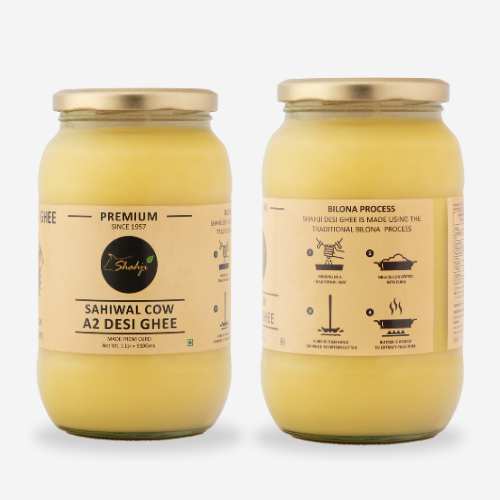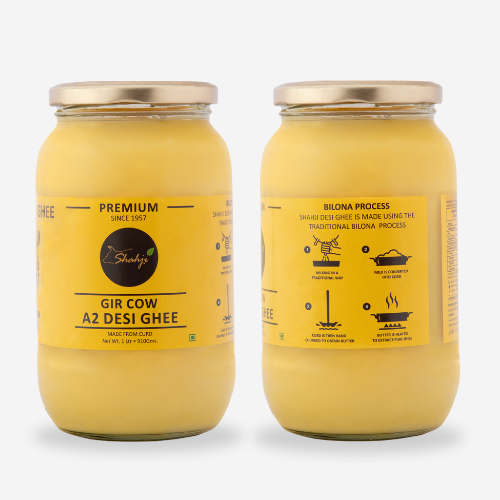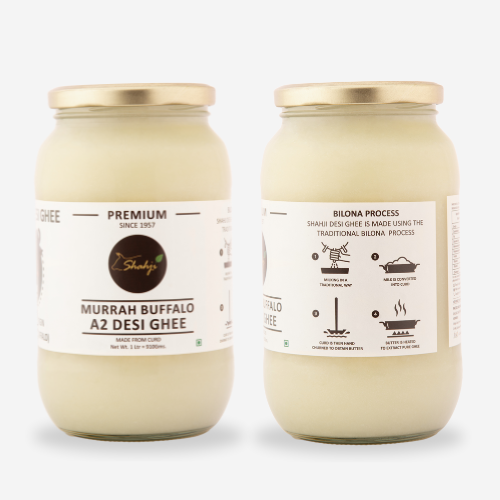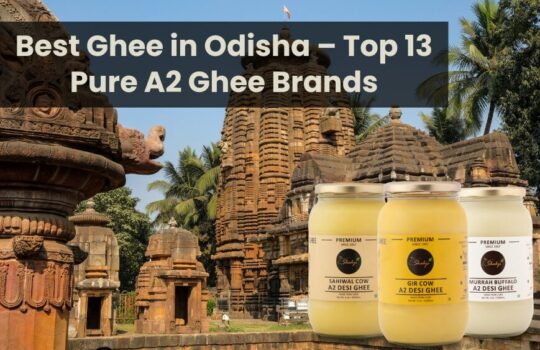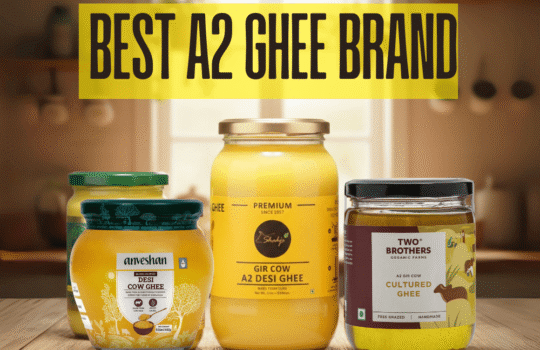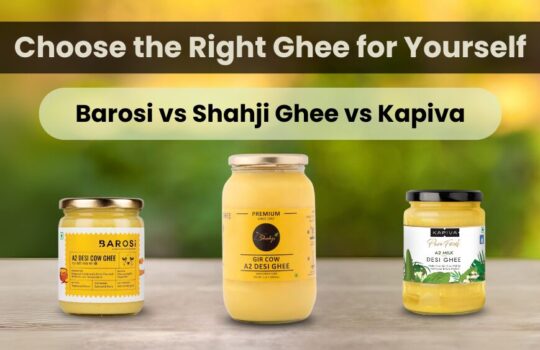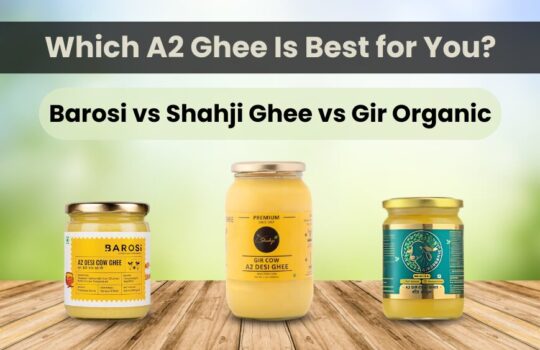Ghee vs Vegetable Oil: The Healthier Fat
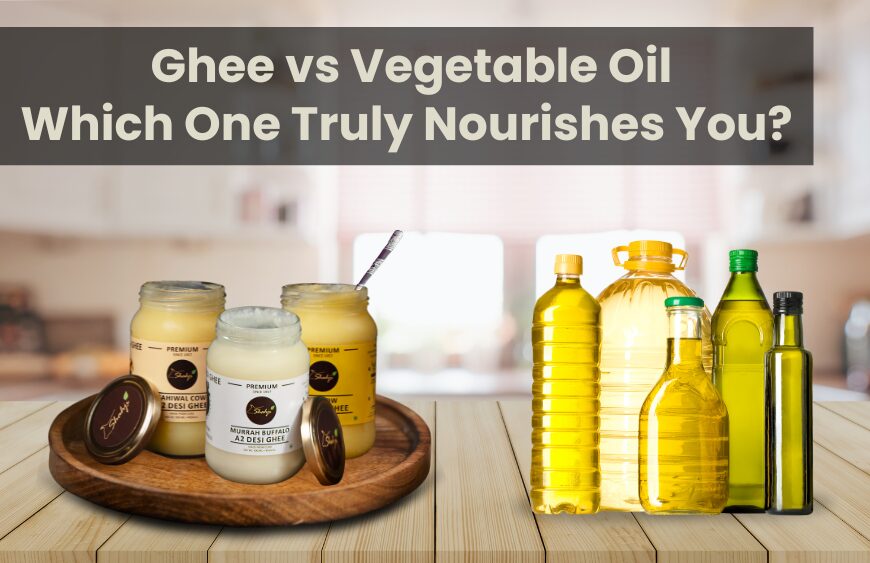
The debate of ghee vs vegetable oil rages in the kitchens of the modern world, as both fat choices have pros and cons. With rising health awareness and dietary preferences, it is essential to be aware of the composition of each fat and its cooking performance and health considerations.
This article will help you understand the benefits, drawbacks, and best culinary uses of ghee and vegetable oil, allowing you to make smarter, healthier choices for you and your family.
What is Ghee?
Ghee is clarified butter that was traditionally used in South Asian cooking. Ghee is made by simmering butter until the milk solids have been removed. It has a rich, nutty flavor with a high smoke point.
Nutritional Highlights of Ghee:
- Rich in saturated fats and short-chain fats like butyric acid
- Contains fat-soluble vitamins A, D, E, and K
- Includes conjugated linoleic acid (CLA), known for its anti-inflammatory and antioxidant properties
Ghee’s traditional roots and Ayurvedic endorsement give it a cultural advantage too, especially in the context of holistic and conscious cooking.
What Is Vegetable Oil?
Vegetable oil refers to a wide variety of oils from plants, including soybean, sunflower, canola, corn, and olive. These oils can be moderately processed and refined to make them neutral in flavor and inexpensive enough to allow for everyday cooking.
Types of Vegetable Oils
- Sunflower Oil
- Canola Oil
- Soybean Oil
- Corn Oil
- Olive Oil
Nutrition & Health Comparison
Fat Content
- Ghee: High in saturated fat which tends to be more stable; recommended for moderation for heart health.
- Vegetable Oil: contains a healthy mix of polyunsaturated and monounsaturated fats- promotes cholesterol regulation and heart function.
Anti-Inflammatory Compounds:
- Ghee: Contains butyric acid and CLA, both known to have anti-inflammatory properties.
- Vegetable Oil: Often high in omega-6, which may cause inflammation when unbalanced with omega-3s.
Smoke Point & Cooking Performance
Smoke Point Comparison:
- Ghee: ~250°C (482°F)
- Vegetable Oil: Ranges from 160°C–230°C depending on type
Ghee is extremely high in smoke point, which makes it great for frying, roasting, and sautéing without breaking down or creating dangerous compounds. Many vegetable oils break down faster and most polyunsaturated oils break down fastest when heated.
Flavor, Culinary Uses & Storage
Flavor:
- Ghee: Adds depth and richness with a caramelized, nutty aroma
- Vegetable Oil: Typically neutral; suitable for salads, baking, or general cooking
Storage:
- Ghee: Long shelf-life, even without refrigeration
- Vegetable Oil: Prone to oxidation; best stored in cool, dark environments
Moderation and Balance – Can you have both?
Yes! If you are going to be balanced, it is important to remember to:
- Using ghee for sautéing and flavouring traditional or high heat dishes.
- Using vegetable oils like olive or avocado oil in salads and light cooking.
- Avoid overuse of refined oils and practice portion control with ghee.
When to Use Ghee vs Vegetable Oil
choose Shahji Ghee when:
- You are frying, sautéing, or roasting at high temperatures
- You want an enriched flavor and golden appearance
Choose Vegetable Oil when:
- You are preparing cold foods like dressings or dips
- You want a neutral base for low-heat cooking.
Why Choose Shahji Ghee?
Legacy of Trust
Established in 1957 incorporating a heritage of purity and excellence, Shahji Ghee was founded in Meerut by Shri Arjun Das Ahuja, known affectionately to all as “Shahji” and is now a name recognized across India for authentic high-quality ghee.
Bilona Method & Small Batch Artisanal Processing
- Shajhi Ghee follows the Bilona Method, an ancient Ayurveda practice using:
- Churning with curd rather than simply using heated cream.
- Low-flame cooking in small batches.
- Earthenware utensils to retain earth energy and nutrition
Because of this traditional preparation, we can retain the beta-carotene, conjugated linoleic acid (CLA), and butyrate compounds are rarely preserved in commercially made ghee or cooking oils.
Sourced from A2 Milk of Indian Breeds
Only A2 milk from Gir cows, Sahiwal cows, and Murrah buffaloes is used. The A2 cow and buffalo breeds produce milk that is richer is A2 beta-casein, which has:
- Easier digestibility.
- More nutrition density.
- Natural richness in omega-3, omega-9 and CLA.
Purity You Can Trust
- 100% Natural, Free of Preservatives, Trans-fats and Additives.
- Lab-tested for quality, safety, and nutritional integrity.
- Hygienically packaged in glass jars providing a shelf-stable shelf life while retaining freshness.
Health and Flavour Benefits
- Improves gut health and increased metabolism through butyric acid.
- Promotes joint and skin health.
- Supports hormones balancing and immunity generating.
- Adds a flavour and aromatic warmth, nutty.
Conclusion
When deciding between ghee and vegetable oil, Shahji Ghee stands out as a cleaner, traditional, and nutrient dense cooking fat. It’s made honestly, sourced from cows producing A2 milk, and slow-cooked in clay pots, which effectively marries ancient customs and modern health science.
Shahji Ghee – whether you want to improve your gut health, cook better tasting meals, or rely on nutrition that has been proven over generations, is a no-brainer which has unparalleled quality and flavor.
Choose Shahji Ghee. Your kitchen—and your health—deserve it.

